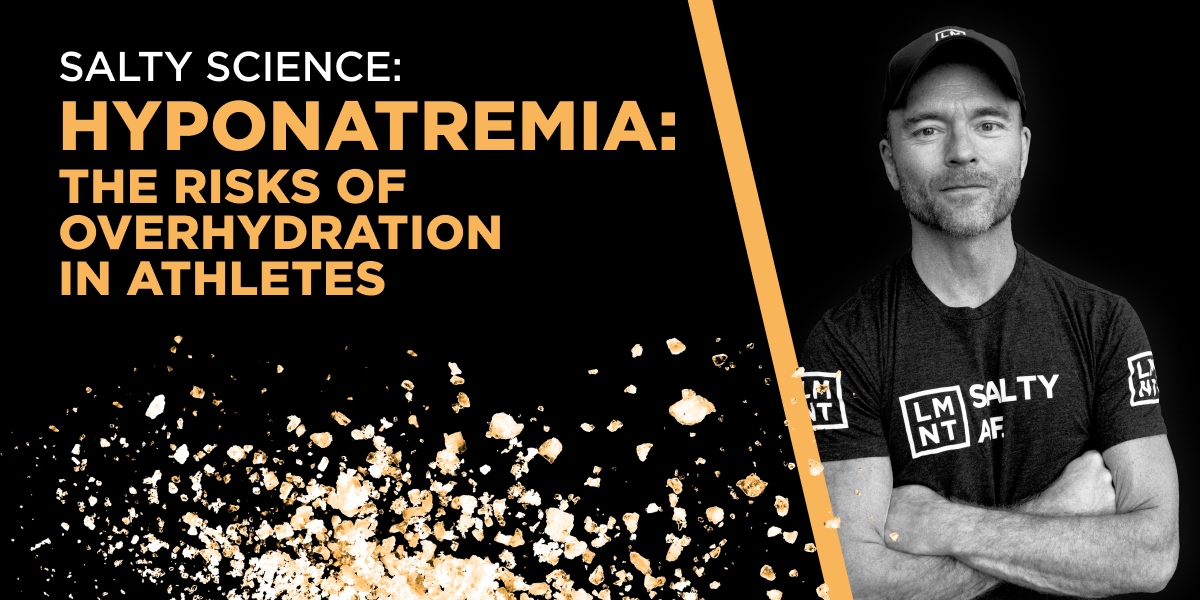Conventional wisdom says that more water is always better. In accord with this belief, many athletes drink beyond thirst in an attempt to prevent dehydration at all costs.
Unfortunately, one of those costs is low blood sodium levels, formally known as hyponatremia. This dangerous condition comes with a whole raft of symptoms. More than a few high-profile cases have made the papers.
“Okay, Robb… Overhydration is serious. But is it really more dangerous than dehydration?”
Yes, it is. I’m not saying we should ignore dehydration. Significant dehydration CAN impair performance and stress the heart. But we need more nuance when discussing fluid and electrolyte replacement for physical activity. Nobody should have to lose their life to something as preventable as exercise-associated hyponatremia.
Still, it’s a tricky balance. The symptoms of overhydration are similar to—and can be easily mistaken for—dehydration. Then people drink more water, worsening their odds. That’s why I want to get the word out: Hydration myths are pervasive, and some simple education about proper fluid-electrolyte balance could save a lot of lives.
Today, I’ll cover everything you need to know about exercise-associated hyponatremia: symptoms, causes, prevention, diagnosis, and treatment. Let’s get started.
Hyponatremia vs. Exercise-Associated Hyponatremia
Hyponatremia occurs when blood sodium levels fall below 135 mmol/L. Common symptoms include fatigue, dizziness, nausea, headache, confusion, and agitation. Severe cases can cause seizures, coma, brain damage, or death.
Common causes of hyponatremia include heart failure, kidney disease, liver disease, cancer diuretics, vomiting, diarrhea, and drinking too much water. The last cause—overhydration—is the most common among athletes, and also the most preventable. It’s the one we’ll focus on today.
If blood sodium levels drop below 135 mmol/L during exercise, or up to 24 hours after, it’s called exercise-associated hyponatremia. As with many hyponatremia patients, the symptoms in hyponatremic athletes are often neurologic.
“They don’t want to speak to anyone,” exercise scientist Tim Noakes says. “They don’t want to look at the lights. When you speak to them, they are extremely dull and slow.”
How do such well-prepared athletes get this way? Overwatering.
What Causes Exercise-Associated Hyponatremia?
The primary cause of exercise-associated hyponatremia is drinking too much plain water. That is because plain water is extremely hypotonic. Compared to cellular fluid, hypotonic solutions contain much lower concentration of solute (dissolved substances).
Distilled water, for example, is as hypotonic as it gets because it’s pure water — there’s nothing dissolved in it. The more sugar, electrolytes, or other substances you dissolve into water, the more you increase the tonicity of a solution. Once the tonicity matches that of our cells, it’s called an isotonic solution. Continue to add solute, and you produce a hypertonic solution.
To recap, overconsuming super dilute (hypotonic) fluids can “water down” your blood sodium content. Over-watering tactics appear to have originated in the US armed forces. In the 80s, the military began encouraging soldiers to consume 1.8 liters of water per hour (holy cats, that’s a lot!) to prevent overheating during training drills. This led to an uptick in hyponatremia among service members, including the death of one trainee. The military has since revised its guidelines, but hydration misinformation such as “drink 8 glasses of water per day!” still persists.
Drinking too much plain fluid is the primary cause of exercise-associated hyponatremia, but researchers believe that antidiuretic hormone (ADH) may play a small role. The function of ADH is to prevent urination, and ADH levels rise during exercise. Combine the lack of urination with aggressive fluid replacement, and you have a recipe for hyponatremia.
Other drivers of exercise-associated hyponatremia include:
- Low dietary sodium intake. A 2017 study found that restricting dietary sodium intake correlated with lower blood sodium levels in 9 cyclists training in the heat.
- Difficulty accessing bodily stores of sodium. It’s unclear why some athletes can’t access their sodium pools, but researchers believe that could contribute to hyponatremia risk.
- Making use of glycogen (stored glucose) releases excess extracellular fluid that may further dilute blood sodium levels.
- Exercise increases gut absorption of fluids and ADH, making it harder for athletes to properly excrete those fluids.
At this point, the sharpest readers among you may have noticed that I didn’t include sweating as a potential driver of hyponatremia. “You’re always talking about how much sodium we lose in sweat! Wouldn’t that deplete blood sodium levels? What gives, Robb?”
It’s true, you do lose a lot of sodium in sweat. However, you also lose water. And compared to our cells, sweat contains a greater ratio of water to electrolytes. In other words, sweat is slightly hypotonic. Therefore, sweating should typically raise blood sodium, not contribute to hyponatremia.
Now that we understand the real cause of exercise-associated hyponatremia (overwatering), let’s talk prevention.
Preventing Exercise-Associated Hyponatremia
In a single sentence: Drink salty water to thirst to prevent exercise-associated hyponatremia. Let’s break that down.
#1: Drink to thirst
Many athletes drink on a set schedule to prevent dehydration, but that’s merely a formula for overhydration. Thirst is a brilliant system honed over millions of years of evolution. It tells you how much fluid you need to feel and perform your best.
There’s no need to drink past what thirst dictates—it tunes into your internal hydration markers like osmolality (the amount of electrolytes in your blood) and blood volume. If you overeat salt, your osmolality rises, triggering thirst. And if you sweat excessively, your blood volume drops, also triggering thirst. Simple and effective.
#2: Replace sodium
When you sweat, you lose significant amounts of water and electrolytes. Since sweat is slightly hypotonic, it makes sense to drink a slightly hypotonic electrolyte drink during exercise. Your goal is to replace both water and sodium in the same ratio that you are losing them—sweat hypotonic, drink hypotonic.
A smart strategy is to add about 1 gram of sodium (or 1 packet of LMNT) per liter of water and sip according to thirst. This solution has close to athletes’ average sweat sodium concentration (826 mg/L), so it can ballpark your sodium needs without sweat testing. Sweat sodium concentration can vary widely between people and training conditions, so listen to your body. Are you craving salt, or plain water? Heed your thirst accordingly.
If you’d like to take a precise approach to electrolyte replacement (as opposed to ballparking it), learn how to optimize your hydration status for exercise.
How Common is Exercise-Associated Hyponatremia?
Thankfully, most cases of exercise-associated hyponatremia are asymptomatic. Routine sodium screening found asymptomatic exercise-associated hyponatremia in:
- 11% of 1,089 Ironman triathletes were hyponatremic post-race
- 70% of 30 elite junior rowers were hyponatremic during training
- 67% of 15 ultramarathon runners were hyponatremic during the race
- 5% of 161 marathon and half-marathon runners were hyponatremic pre-race
At the very least, asymptomatic cases will subtly impact your performance. At the worst, they’re a short hop to symptomatic cases, which affect up to 1% of endurance athletes.
Ironman athletes, marathon runners, ultramarathon runners, long-distance backpackers, and military service members are the most commonly affected groups, but any active person can be at risk. There’s no downside to staying ahead.
Diagnosing Exercise-Associated Hyponatremia
Proper diagnosis relies on blood sodium testing by a doctor. But since sodium screening isn’t always available at the drop of a hat, athletes and trainers must rely on other methods in the field.
If an athlete has symptoms of hyponatremia, that’s a vital clue. However, the symptoms can overlap with other diagnoses such as heat exhaustion, heat stroke, hypovolemia, hypoglycemia, sudden cardiac arrhythmia, cardiac muscle weakness, and dehydration, to name a few.
Misdiagnosis and improper treatment can lead to brain damage, so it’s crucial to understand the context. Was the patient drinking tons of hypotonic fluids while training, or is something else going on? Understanding the patient’s background helps dictate the treatment plan. Let’s dig into that now.
Treating Exercise-Associated Hyponatremia
Nearly all cases of exercise-associated hyponatremia are reversible with prompt treatment. Prompt treatment can save lives by preventing complications like encephalopathy (brain damage), rhabdomyolysis (rapid muscle damage), fluid in the lungs, and demyelination (damage to nerves in the brain).
The goal of treatment is to normalize serum sodium levels and reverse symptoms. The type of treatment will depend on the degree of neurologic symptoms, and is best determined by a qualified medical professional. That said, if you don’t have access to a doctor and need to act quickly, I’ve provided three scenarios below to illustrate.
Scenario 1: Mild symptoms
The athlete has mild symptoms like fatigue, nausea, and dizziness but nothing neurologic in nature. There are two recommended treatment options: (1) fluid restriction, and (2) oral hypertonic solutions.
Standard practice is to halt exercise and restrict fluids until ADH levels drop and the patient starts urinating again. Urination excretes excess fluids and restores blood sodium levels.
However, clinicians may also choose to replenish salt as needed. They commonly use:
- 100 mL of hypertonic 3% NaCl solution taken orally (1,200 mg sodium)
- 125 mL of water with 3–4 bouillon cubes taken orally (2,760–3,680 mg sodium)
- Salty foods like pretzels
Drinking salty fluids may be the easiest resolution for mild cases. For instance, a 2014 randomized controlled trial found that drinking salty water was equivalent to IV saline in reversing mild hyponatremia in 26 ultra-distance runners. And a 2020 randomized controlled trial found that oral saline was more effective than IV saline for treating mild to moderate cases of exercise-associated hyponatremia in 20 triathletes. The average time to hospital discharge was only 50 minutes for the oral group, compared to 76 minutes for the IV group.
Other evidence suggests that an isotonic 0.9% saline solution can treat exercise-associated hyponatremia too, albeit much more slowly. Compared to hypertonic saline, isotonic saline contains a lower concentration of sodium — about 360 mg sodium per 100 mL (3.4 ounces) of water.
Scenario 2: Neurologic symptoms
If the patient is confused, agitated, light-sensitive, lethargic, dull, or experiencing phantom running (involuntary leg movement at rest), the National Institutes of Health recommends IV saline treatment. For this degree of symptoms, clinicians typically administer 100 mL of 3% saline every 10 minutes for a total of 3 doses.
Scenario 3: Severe neurologic symptoms
The most severe symptoms include seizure, coma, and mydriasis (dilated pupils)—all signs of encephalopathy.
If the patient demonstrates these symptoms, clinicians may give 100 mL of 3% saline intravenously every 10 minutes until symptoms dissipate. In one case study, a marathon runner required 950 mL of 3% saline to reverse encephalopathy. In another, doctors used 40 mL of super salty 20% saline in an endurance swimmer experiencing seizures.
Left untreated, severe neurologic symptoms could lead to the patient passing—so it’s vital to get them medical help as soon as possible.
Drink Salty Fluids to Thirst
While it’s best to leave hyponatremia treatment to the doctors, you do have the power to prevent it in the first place. A simple strategy to do so? Drink salty water to thirst, and not beyond it.
Making these fluids is easy. Use LMNT or mix your own DIY electrolyte drink. Then, sip to thirst before, during, and after exercise. That’s it. This simple strategy could save lives, so spread the word!

